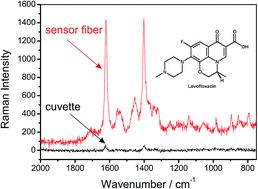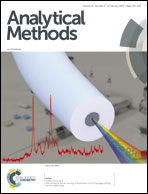Fiber enhanced Raman sensing of levofloxacin by PCF bandgap-shifting into the visible range
Abstract
Fiber enhanced Raman spectroscopy is introduced for chemically selective and sensitive monitoring of antibiotics in aqueous media. The bandgap of a hollow core photonic crystal was blue shifted, in order to provide low loss light guidance in the important visible range in a water filled central core of the fiber. Such a sensor fiber provides a spectral window for light guidance for a complete Raman spectrum up to 4000 cm−1 with λexc = 532 nm and enables an extremely strong light–analyte interaction within the liquid-filled fiber core. It was shown that a precise optical coupling must be guaranteed, in order to provide strong analyte signals and to avoid background noise. The fiber itself was used as an optical waveguide and also as a miniaturized sample container for antibiotic solutions. A strongly improved analytical sensitivity could be achieved and it was possible to improve the limit-of-detection for the frequently used broad spectrum antibiotic levofloxacin down to clinically relevant concentrations of 20 μM with only 8 nL sample volume in the fiber core. Fiber enhanced Raman spectroscopy has great potential as a new point of care tool for chemical selective and ultrasensitive monitoring of antibiotic levels, enabling rapid dose adjustment in critically ill patients with severe infections, who require individual dosing due to large inter- and intra-individual changes in pharmacokinetic properties.



 Please wait while we load your content...
Please wait while we load your content...